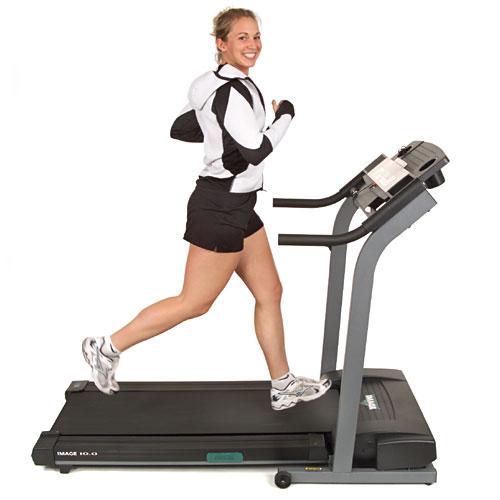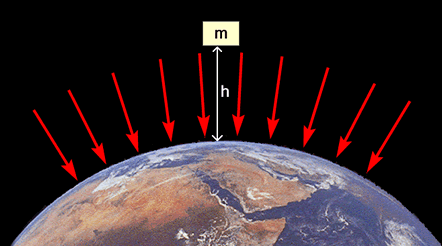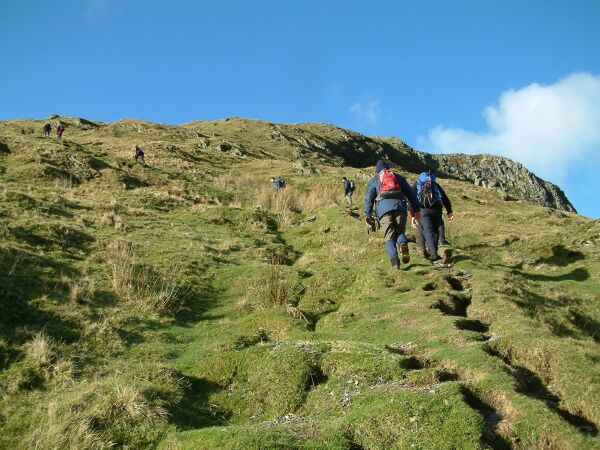A bad day for your ego is a great day for your soul. -Jillian MichaelsOne of the most popular exercises at the gym is the treadmill. And why wouldn't it be? Whether you're running or walking, it's a great way to get your heart rate up, get your body moving, and for many people, a great way to burn calories.

But however you use a treadmill, there's one extremely simple thing you can do to dramatically intensify your workout: incline it!

If you're an outdoor walker/runner, this is the equivalent of going uphill instead of over level ground. There are many physiological differences in walking along an incline versus on level ground, but what does physics have to say about it?
Normally, if you're on level ground (or a level treadmill), you stay at the same level in the Earth's gravitational field.

But if you walk uphill (or on an inclined treadmill), you not only need to move forward at whatever pace you were moving at, you also need to climb -- a little with every step -- out of the Earth's gravitational field!
The Earth's gravitational field is no slouch, either. I'm an 80 kg individual, and for me to raise my elevation by just 5.3 meters (about 17 feet) costs me 4,200 Joules of energy, also known as one food calorie.

Now, if I actually exercise, I burn significantly more than one calorie by raising myself those 5.3 meters. Why? The two most significant reasons are as follows:
- I am not a perfect engine. This means, in order for me to do 4,200 Joules of physical work, I need to burn about three times as much in food energy in order to get that much useful energy out. Alas, our bodies are inefficient in that manner.
- When you exercise and then stop, your body doesn't know that it's okay for your heart to slow down for quite some time. So spending an hour walking uphill will elevate my metabolic rate for a lot longer than an hour!

Let's make a helpful table. We'll just look at the total distance you travel (e.g., if you walk at three miles-per-hour for one hour, you go three miles), put in the incline, and see how much extra physical work you need to do!
| Distance (miles) | Distance (km) | Incline (degrees) | Extra Work (Calories) |
|---|---|---|---|
| 1.0 mi | 1.6 km | 1 degree | 5.3 Cals |
| 1.0 mi | 1.6 km | 3 degrees | 15.8 Cals |
| 1.0 mi | 1.6 km | 5 degrees | 26.3 Cals |
| 1.0 mi | 1.6 km | 10 degrees | 52.3 Cals |
| 2.0 mi | 3.2 km | 1 degree | 10.6 Cals |
| 2.0 mi | 3.2 km | 3 degrees | 30.6 Cals |
| 2.0 mi | 3.2 km | 5 degrees | 52.6 Cals |
| 2.0 mi | 3.2 km | 10 degrees | 104.6 Cals |
| 3.0 mi | 4.8 km | 1 degree | 15.9 Cals |
| 3.0 mi | 4.8 km | 3 degrees | 47.4 Cals |
| 3.0 mi | 4.8 km | 5 degrees | 78.9 Cals |
| 3.0 mi | 4.8 km | 10 degrees | 156.9 Cals |
| 5.0 mi | 8.0 km | 1 degree | 26.5 Cals |
| 5.0 mi | 8.0 km | 3 degrees | 79.0 Cals |
| 5.0 mi | 8.0 km | 5 degrees | 131.5 Cals |
| 5.0 mi | 8.0 km | 10 degrees | 261.5 Cals |
| 10 mi | 16 km | 1 degree | 53 Cals |
| 10 mi | 16 km | 3 degrees | 158 Cals |
| 10 mi | 16 km | 5 degrees | 263 Cals |
| 10 mi | 16 km | 10 degrees | 523 Cals |
This is all for a person with a mass of 80 kg (about 176 pounds). Isn't that a spectacular difference? In other words, if you make a long-term change from walking on a flat ground (or treadmill) to walking up inclined ground (or an inclined treadmill), you burn extra energy with every step you take!
And what's with the Jillian Michaels quote? Well, I'm no longer the fittest guy on scienceblogs; say hello to Travis and Peter over at Obesity Panacea, our newest ScienceBlog! But whatever you're doing, don't forget to take the time to get out there and do something active; you'll feel better and you'll be healthier. And who doesn't want a higher quality of life?





Comments
And this is why I bought a NordicTrack Incline Trainer X3. It goes up to 40% incline!
Posted by: Brian Shiro | March 10, 2010 8:41 PM
When you exercise on an inclined treadmill you do *not* climb out of the Earth's gravitational field, but you keep your distance from the center of the earth constant. So, what do you want to tell us here?!
Posted by: Duncan Ivry | March 10, 2010 8:43 PM
Duncan, every step you take is a step out of the Earth's gravitational field. It's not the Earth's fault that the treadmill is constantly pulling you back, and deeper into the Earth's gravitational field! (Stair-steppers work the same way, FYI.)
Posted by: Ethan Siegel | March 10, 2010 8:49 PM
Some physics isn't quite right here.
Last time I was on an inclined treadmill, my head (and attached torso) did NOT go "UP" as I hiked along. Most of me stayed at the same gravitational potential.
I did have to lift my legs more than on a flat treadmill but that, near as I can tell, was the only additional work I had to do. Not nearly as much work as climbing a hill.
Posted by: JDStackpole | March 10, 2010 9:22 PM
JDStackpole, I would think it is MORE work than climbing a hill because on a hill you get higher up and the gravitational field is weaker. On a treadmill, you stay at the same field level.
Posted by: NewEnglandBob | March 10, 2010 9:33 PM
| March 10, 2010 9:33 PM
Nope. Gravity just doesn't drop off that fast. It's a minuscule (and undetectable by a climber) difference on any hilltop or mountain top relative to the valley.
Posted by: JDStackpole | March 10, 2010 9:53 PM
am a fan of your blog. will your next post be the physics of manny pacquiao's power and speed? i love boxing and wants to know a bit of physics too. :) thanks.
Posted by: bonvito | March 10, 2010 10:34 PM
No, really, I'm not lifting my body up any distance at all. It stays just about level even with a steep incline. When I climb actual stairs, my body goes up. The only extra work being done is lifting my legs a bit more. It's high-stepping; not a bad thing but not the same as climbing a hill.
Posted by: george.w | March 10, 2010 10:37 PM
the effect of altitude on gravity is relatively negligible. but if you wanted to get real exact... yes, you would be expending less energy climbing at an altitude of 10,000 feet.
Posted by: Sam Pennella | March 10, 2010 10:38 PM
If you want to put anything to do with a treadmill in terms of work, you get zero because there is zero displacement at the end when you get off. Actually moving up or forward doesn't get you the right answer in this case. You have to look at this incrementally because you don't get back the energy you burn as you "fall" back down. That being said, there is a great deal of evidence to suggest that running on a treadmill isn't as hard as pounding the pavement. Many marathon runners have found this out the hard way on race day.
Posted by: geopig | March 10, 2010 10:38 PM
it definitely isn't as hard as running on pavement. you have to push off with each step effectively using more muscle fibers in your toes and feet.
Posted by: Sam Pennella | March 10, 2010 11:22 PM
"it definitely isn't as hard as running on pavement."
And it definitely isn't as hard on your joints as running on pavement. Save your knees - use a tread mill - (or run on dirt)!
When I do the treadmill instead of outdoors exercise, I like to put the incline up to 15% (max on that machine). I feel like I'm using a lot more of the power in my legs - and I am. The treadmill is moving me backwards and downwards every second, and every second, I clime to maintain my position.
Posted by: Jackal | March 11, 2010 12:03 AM
Hello Ethan!
Thanks for the blog shout-out and the wonderful post.
Many of the participants that volunteer to exercise in our weight-loss studies, especially the older individuals, really prefer to keep the speed rather moderate but increase the incline. This ensures their heart-rate stays elevated, and they get a decent workout without having to run too briskly, thus reducing some of the impact on their joints. On the other hand, when doing maximal stress tests on our participants using a protocol which progressively increases the incline of the treadmill until they fatigue - I've seen a few cases where people stop the test due to severe cramping and discomfort in the lower legs. Thus, while walking up an incline may help burn a few extra calories - this needs to be considered against the potential reduction in exercise time due to cramping, or discomfort. From my experience, 1-3 degrees incline seems to be very doable for most people.
Posted by: Peter Janiszewski | March 11, 2010 12:07 AM
As part of my daily session at the gym, I do 3 km on the treadmill (if I'm lucky) at 6 degrees incline, so that means I'm doing only an extra 50 kcals of exercise. Damn!
Posted by: waynerobinson4 | March 11, 2010 12:07 AM
| March 11, 2010 12:07 AM
I'm agreeing with Duncan and JD on this one. Unfortunately inclining the treadmill isn't going to increase your calorie consumption as much as actually climbing a hill. The only effect the gravitation will have is on the legs having to be lifted higher, feel the burn :)
Posted by: William Paysinger | March 11, 2010 2:00 AM
running on and incline on a Running machine is not as hard as running on the road. The have to take out the effort afforded by the motor moving your legs backwards,
Posted by: John cornish | March 11, 2010 3:03 AM
According to Sir Isaac if a body has a relative motion in the vertical direction that is not accelerating then the laws of physics act as in every other non-accelerating frame including zero vertical motion.
While not actually rising, the legs fight the same acceleration of gravity as if the body were.
The same relative velocity effect acts in the horizontal so while your body remains on the treadmill you are pushing backwards the same as if walking the slope but without boundary of the machine.
Posted by: Ishmael | March 11, 2010 6:58 AM
Another advantage to incline training is that it can be less stressful to your joints. If you walk at a steep incline you can burn as much, if not more calories than if you are running on a level terrain. Running causes extreme impact. In fact, I read where running at a fast pace can cause the impact to be 2.5X your body weight. That's why many runners have to find alternative forms of exercise as they age. The popularity of elliptical trainers is partially from aging baby boomers who are looking for a form of exercise with less impact.
Posted by: Fred Waters | March 11, 2010 11:38 AM
While not a physicist (I used to be a chemist, but fortunately I have since fully recovered) I was at first surprised how many commenters don't agree that inclining the treadmill means working harder against gravity, even though the runner stays at the same elevation. But thinking about it, I can see why it's not immediately obvious.
By the same token, why does running on a treadmill on the flat require work (once up to constant speed)? After all, Newton's laws say that no force acts on a body that's not accelerating, and work done is the (integrated) product of force applied by distance travelled. The reason is because the runner needs to exert a backwards force along the bed of the treadmill to overcome its friction, which would otherwise pull him/her backwards. (Note that a somewhat greater force is needed when running without a treadmill, as then the runner moves relative to the air and has to overcome its resistance as well as that of the floor. Also, there must be some secondary forces needed to stabilise the body and avoid falling over.)
It's now much easier to see that if the treadmill bed is inclined, the force acting along its length has a gravitational as well as a frictional component, and the runner has to work harder to overcome both.
I know this is just a long-winded version of what others have said, but hopefully helps to clarify what's going on.
Posted by: Hilary PhD | March 11, 2010 11:46 AM
Me again. Just to add to what Fred Waters and Peter Janiszewski said, I don't think it's just about avoiding impact.
For a given type of exercise, you can raise your work-rate either by moving faster or by increasing the resistance to be overcome and therefore the force you apply. Some people's muscles seem to suit increased speed, others increased force. Modern cardio machines allow inclines and variable resistance so that each person can find a balance that suits them personally.
Posted by: Hilary PhD | March 11, 2010 12:06 PM
Ethan: "... It's not the Earth's fault that the treadmill is constantly pulling you back, and deeper into the Earth's gravitational field! ..."
No, it does not work like that. people on a treadmill stay at the same position vertically and horizontally all the time, and the surface of the treadmill roles away under their feet. If you want to have the effect of "pulling you back" you first have to run several steps forward and upward, then slow down, and let the treadmill *then* pull you back -- and this again and again. I have never observed people doing it like this.
It is like JDStackpole said: "I did have to lift my legs more than on a flat treadmill but that, near as I can tell, was the only additional work I had to do. Not nearly as much work as climbing a hill."
And above all that, exercising on an inclined treadmill is bad for the joints in the long run -- pun intended -- and even if Fred Waters above says the opposite -- because the feet are in a less natural position all the time. Because of this its also bad for the Achilles string (I hope this is the correct word). I would even say: If you want to ruin your feet, use an inclined treadmill.
To Hilary PhD:
A lot of physical work -- may be, even most of it -- has to be done inside the body. Different muscles have to move the body's parts in different directions again and again. Think about the heart, the lungs, the brain, etc., and the transport of all the substances the body needs.
Posted by: Duncan Ivry | March 11, 2010 12:53 PM
when you jog on a treadmill, you're primarily using your femoral extensors and flexors as well as the gastroc and anterior compartment. you don't use plantar flexors nearly as much as you do when running on pavement.
for an incline, you're adding a stair stepping motion to the run. => more calories.
that's the bottom line.
run for 3 mi on a tredmill one day. take a break. then 2 wks later, run 3 mi on pavement. I guarantee you that you will feel much more soreness in the dorsum of your feet.
add an incline to THAT... and there's your difference
Sam Pennella
Posted by: Sam Pennella | March 11, 2010 2:33 PM
@Duncan Ivry
I agree some internal work has to be done - I mentioned stabilising the body and Ethan mentioned physiological inefficiency (his indented point 1). Neither of that alters the fact that the force the runner has to exert against the treadmill is increased by a (quite significant) gravitational component if the treadmill is inclined.
Please learn something about the physics of vector forces.
Posted by: Hilary PhD | March 11, 2010 4:32 PM
Please review and update, if necessary, your contact information. I was unable to e-mail some relevant material to you that is too long for the comments.
Posted by: Bernard Leikind | March 11, 2010 5:31 PM
Hilary PhD: "... the force the runner has to exert against the treadmill is increased by a ... gravitational component if the treadmill is inclined."
I do not know, where this gravitational component should be. As far as I can tell, a person on an inclined treadmill has an inclined orientation of his/her feet, but nothing else.
"Please learn something about the physics of vector forces."
Thank you for pointing me into this direction. A poor, old mathematician has difficulties understanding just this ;-)
But to the point:
Let us observe a person on an inclined treadmill! Does the person move to a greater distance in the gravitational field of the earth, i.e. in a direction from the floor to the ceiling? No.
Is there work done by going along a path -- going along a path! -- up in the gravitational field excerting a force against gravitation pulling down? No.
We have to consider the "the line integral of F dot ds", with F = force, ds = infinitesimal path; see e.g. Richard Feynman's Lectures on Physics, page 14-1. Interestingly, Feynman writes on page 14-2: "... running upstairs is considered as doing work ..., but in simply holding an object in a fixed position, no work is done." Then Feynman goes on explaining how physiological work occurs -- muscles, nerves, etc. -- and how it differs from physical work.
The person on the treadmill is the "object", and the person holds "itself" in a fixed position relative to the gravitational field. Ergo: No physical work is done.
This is *the* important piece: No path, no work!
@ Ethan: I think, you have access to the Feynman Lectures. Please read these two pages, and tell what you think.
Anyway ... this is my last comment on this topic.
Posted by: Duncan Ivry | March 11, 2010 7:11 PM
But - your height is not changing at all although your footing may be more awkward. I'm with JDStackpole; I can't imagine the slight increase in work being anything like climbing a mountain.
@Brian: 40 degrees is extremely steep; I carry rope when I walk up/down terrain with that grade - do you really use it at such a setting?
Posted by: MadScientist | March 12, 2010 4:37 AM
@MadScientist he said 40%, not 40 degrees, so it's more like 22 degrees (I think)
Posted by: Emlyn | March 12, 2010 5:48 AM
Duncan Ivry asks: "Is there work done by going along a path -- going along a path"
The answer is yes. The path is the motion of the person RELATIVE to the bed of the treadmill.
I rather wonder how many of the people who talk about "slight increase in work" have any actual experience of walking quickly (I wouldn't run, but I hate running on the flat as well) on an inclined treadmill.
Posted by: Hilary PhD | March 12, 2010 5:58 AM
Skipping over the "I'm not going up on a stairclimber, therefore I'm not doing any work" silliness, there's another interesting issue here:
The "extra work" figure is only meaningful if you have a "baseline work" number to compare it to.
That makes for an interesting order-of-magnitude physics calculation. Obviously if we had wheels, we could "run" on a horizontal treadmill with (in the limit of perfect wheels) no effort. So where's the work coming from? I'd guess two main contributors:
1) The up and down motion involved in running and walking (in theory if our bodies were perfect springs, etc. we could regain the energy expended, but I don't think that's the case)
2) The acceleration of our legs and arms back and forth (again, if our muscles could act as springs, etc. we could regain this energy, but I'm pretty sure that's not the case).
Neglecting #2 and just considering #1, I'd guess that at each stride we're looking at an increase in body center-of-mass height that's roughly 5 to 10% of the stride length. So your baseline work would be equivalent to the "extra work" associated with the 5 to 10% incline numbers.
Posted by: Anonymous Coward | March 12, 2010 3:44 PM
Wow - very scientific - enjoyed reading your explanation. I always walk at an incline on my treadmill. I set it up to the maximum incline and work out -
Posted by: Sandy | March 12, 2010 6:39 PM
uh...as a physiologist you're a pretty good physicist. Your body is not stupidly fooled--metabolic rate (and, essentially, therefore heartrate) remain elevated post-exercise for good reason: there is a lot of chemical work to be done to mop up after exercise.
But the extra work in "high-stepping" is not all (or even mostly, I bet) being done by the leg that is stepping up--your power leg pushes the hip forward. On an incline there is an additional upward vector to that pushing force, and that accounts for most of the additional energy required.
I think.
Posted by: Sven DiMilo | March 13, 2010 11:41 AM
When walking horizontally, you place your front foot on the same level as the rear foot. Then walking up a treadmill at 10 degree elevation, and taking steps of 2 ft, the front foot is placed about 4 inches higher than the rear foot.
As you begin to transfer your weight to the front foot, your body must rise further than for a similar horizontal pace. The net effect is smaller than when walking up a 10 degree ramp because the treadmill surface is moving steadily backwards.
I suspect that an engineering approximation is that the body rises about 2 inches higher during each step, compared to the trajectory for walking horizontally. Calorie consumption would then perhaps be about the same as for walking up a ramp with half the treadmill slope.
Are there experimental measurements of oxygen consumption on treadmills of different slopes which could resolve the issue.
Posted by: Keith C | March 13, 2010 5:04 PM